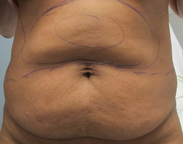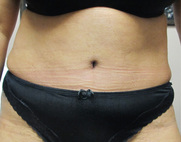Tummy TuckMen and women who have experienced dramatic weight loss, either through diet and exercise, or as a result of bariatric surgery, often have excess amounts of skin around the abdomen. Women can also experience this condition as a result of pregnancy, making the abdomen soft and flabby. A tummy tuck, also known as Abdominoplasty, can remove excess folds of skin and tighten your abdominal muscles to create a lean, flat and more well-defined stomach. It can also diminish unsightly stretch marks.
Because diet and exercise cannot remove the excess skin, abdominoplasty is the perfect solution to tone and refine the abdomen. The effects of tummy tuck can be long lasting, provided you exercise regularly, eat a sensible diet, and maintain a suitable weight level. For more before and after Tummy Tuck pictures click here. WARNING - Images are graphic.
Tummy Tuck Recovery
Tummy tucks are major abdominal surgery performed with general anesthesia. After awaking, the patient feels groggy and tired for several days. The area may be covered in surgical dressings or a compression garment, and there will also be fluid drains and sutures to contend with. Your abdomen will feel swollen and sore. Bruising and redness are also common. These side effects generally take one to three weeks to subside. During this time, follow your surgeon’s aftercare instructions to reduce swelling, promote healing, and support the tissues as they adjust to their new contours. Most patients are able to return to work in about two weeks, though strenuous activities must be avoided for six weeks or more. |
Medical Spa Treatments
Acne Acne Scarring Botox Chemical Peels Dermal Fillers Dermaplaning Excessive Sweating Laser Hair Reduction Lip Enhancement Microdermabrasion Microneedling Skin Care Products Skin Rejuvenation Skin Resurfacing Spider Vein Reduction Sun Damage Tattoo Removal Specials Surgical Procedures Arm Lift Body Lift Breast Augmentation Breast Lift Breast Reconstruction Breast Reduction Brow Lift Ear Pinning Earlobe Repair Eyelid Rejuvenation Face Lift Fat Transfer Hand Surgery Hernia Repair Keloid Scar Lip Augmentation Liposuction Male Breast Reduction Mole Removal Mommy Makeover Neck Lift Rhinophyma Scar Revision Skin Cancer Thigh Lift Tummy Tuck Vaginal Rejuvenation |
ORLAND PARK PLASTIC SURGERY
Privacy Policy | Links | Location | Specials
© 2004-2024 Orland Park Plastic Surgery, S.C., all rights reserved • 708.873.9600




